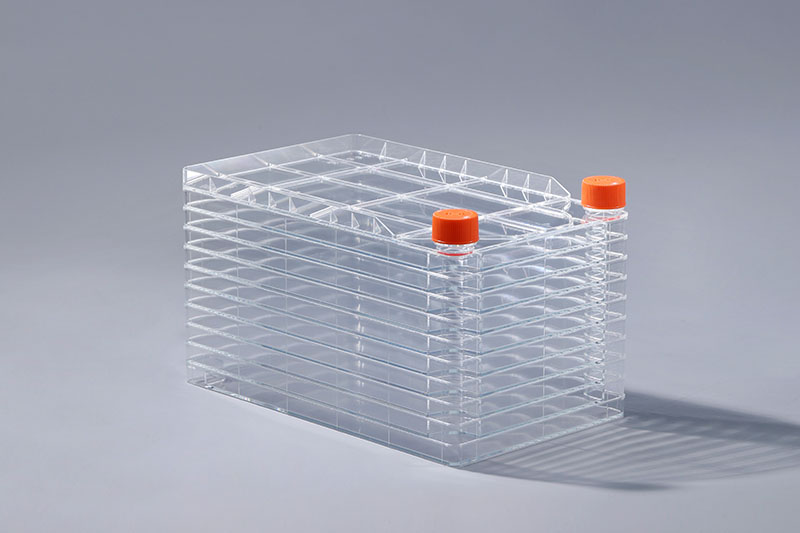- гэта шматслаёвая структура расходных матэрыялаў для культуры клетак, перавагамі якой з'яўляюцца вялікая плошча культуры, невялікая колькасць расліннай прасторы і нізкая ступень забруджвання. Для таго, каб гарантаваць якасць прадукту, патрабуюцца розныя тэсты, і адзін з іх - першапачатковы тэст на забруджванне. прадукт, які падлягае стэрылізацыі. Гэта лімітавы мікробны тэст, які адносіцца да ступені мікробнага забруджвання неўдакладненых стэрылізаваных прадуктаў і сыравіны, дапаможных матэрыялаў і гатовай прадукцыі перад стэрылізацыяй, уключаючы колькасць забруджвання і кантрольных бактэрый. , гэта значыць звычайны падлік калоній, агляд палачкі і патагенных бактэрый. Мэта гэтага тэсту - забяспечыць эталонны індэкс для наступнай стэрылізацыі фабрыкі клетак, напрыклад, дозу стэрылізацыі, каб забяспечыць эфект стэрылізацыі. Можна сказаць, што гэта тэст для кантролю эфектыўнасці працэсу стэрылізацыі.To рэзюмуючы, мэта першапачатковага выяўлення забруджвальных бактэрый на фабрыцы клетак - пацвердзіць стэрылізацыйную дозу, кантраляваць эфектыўнасць працэсу стэрылізацыі і такім чынам забяспечыць стэрыльнасць прадукту.Для аналізу біялагічнай нагрузкі было ўзята не менш за 10 узораў з трох асобных партый прадукту для тэставання. Аналіз біянагрузкі павінен праводзіцца ў адпаведнасці з правераным і даступным метадам. Была разлічана сярэдняя біянагрузка кожнай партыі і сярэдняя біянагрузка 30 узораў была выкарыстана ў якасці агульнай сярэдняй біянагрузкі трох партый. Калі сярэдняя біянагрузка адной з трох партый у два ці больш разоў перавышае агульную сярэднюю біянагрузку, для праверкі дозы выкарыстоўваецца сярэдняе сярэдняе па партыі, у адваротным выпадку для праверкі дозы выкарыстоўваецца агульнае сярэдняе з трох партый.
Generally speaking, the initial contamination bacteria test is the estimated value of the bioburden of the product to be sterilized. It is a microbial limit test, which refers to the degree of microbial contamination of non-specified sterilized products and raw materials, auxiliary materials and finished products before sterilization, including the amount of contamination and control bacteria. , that is, the usual colony count, coliform and pathogenic bacteria inspection. The purpose of this test is to provide a reference index for the next sterilization of the cell factory, such as the sterilization dose, so as to ensure the sterilization effect. It can be said to be a test to monitor the effectiveness of the sterilization process.
For bioburden analysis, at least 10 samples were drawn from three separate batches of product for testing. Bioburden analysis must be performed according to a validated and available method. The average bioburden of each batch was calculated and the average bioburden of 30 samples was used as the total average bioburden of the three batches. If the average bioburden of one of the three batches is two or more times greater than the total average bioburden, the batch average is used for dose verification, otherwise, the overall average of the three batches is used for dose verification.
To sum up, the purpose of the initial contaminating bacteria detection in the cell factory is to confirm the sterilization dose, monitor the effectiveness of the sterilization process, and thus ensure the sterility of the product.
The FAI climbed 5.9 percent year-on-year in the first 11 months of 2018, quickening from the 5.7-percent growth in Jan-Oct, the National Bureau of Statistics (NBS) said Friday in an online statement.
The key indicator of investment, dubbed a major growth driver, hit the bottom in August and has since started to rebound steadily.
In the face of emerging economic challenges home and abroad, China has stepped up efforts to stabilize investment, in particular rolling out measures to motivate private investors and channel funds into infrastructure.
Friday's data showed private investment, accounting for more than 60 percent of the total FAI, expanded by a brisk 8.7 percent.
NBS spokesperson Mao Shengyong said funds into weak economic links registered rapid increases as investment in environmental protection and agriculture jumped 42 percent and 12.5 percent respectively, much faster than the average.
In breakdown, investment in high-tech and equipment manufacturing remained vigorous with 16.1-percent and 11.6-percent increases respectively in the first 11 months. Infrastructure investment gained 3.7 percent, staying flat. Investment in property development rose 9.7 percent, also unchanged.
 English
English



















































